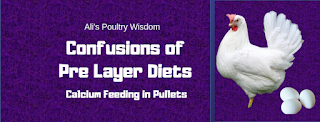Confusions of pre layer diets – the feeding management
Using a pre-layer diet has obvious benefits but might also predispose pullets to kidney failure.
Excess calcium in diets disposes kidneys on excessive burden of calcium filtration which damage soft tissue

What is pre layer formula?
- A pre-layer diet is a special formula, rich in calcium, which is being offered to developing pullets during the last couple weeks before they start laying their first eggs.
- In most cases, this is during the period from the 16th until the 18th week of age.
How pre layer ration differs from developer diets?
- There are many small variations between a developer diet and its follow-up, the pre-layer diet, but in essence, the major difference is the calcium concentration.
- Developer diet contains no more than 1 percent calcium, a pre-layer diet can contain anything between 2 and 2.5 percent calcium
Why such Sudden increase in calcium feeding?
- The reasoning behind this calcium flush is that the medullary bone structure develops rapidly after the 15th week of age.
- Thus, the late developing phase is ideal to maximize bone calcification.
- After all, bone calcium deposits are key in eggshell formation during the daily calcium cycle of layers.
What if we do not give such high calcium?
- Without such calcium loading, the earlier-maturing pullets will produce two to three eggs before stopping & start replacing bone calcium reserves
- This cycle repeats; 2-3 eggs clutch and pause even when hen is capable to give 30 eggs clutch
Than what is the harm of this practice?
- Early calcium rich pre-layer diet burdened kidneys too early with high calcium levels, which can lead to kidney problems later on when bird gets old and offer 4% calcium diets…
- Some nutritionists also suggest a faster drop in calcium absorption efficiency with age when pullets are started too early on high-calcium intake.
2 options? dilemma?
- Farmers need to decide between having a number of earlier-maturing pullets starting to lay eggs before their time and using insufficient bone reserves (and thus entering the layer house with depleted bone reserves) or risk kidney overload
Timing of eggshell formation
- Egg formation begins with the formation of the yolk and albumen, which requires protein and energy deposition to occur early in the day.
- This requirement coincides with the feed consumption peak period.
- Later on, calcium requirement for eggshell formation peaks starting from early afternoon until late evening hours.
- At this time, feed intake is minimal and meeting calcium requirement depends on calcium absorbed through feed earlier on and on calcium release from bone reserves.
Limited bone reserves
- Readily available calcium bone reserves amount to about 1,000 mg, of which the hen can mobilize no more than 100 mg per day.
- When calcium-deficient diets are fed for a prolonged period of time, these reserves are depleted within days, and damage might occur if the hen starts mobilizing calcium needed for structural purposes — hence, locomotion problems in layers fed diets deficient in calcium.
Coarse calcium sources (grit)
- Feeding calcium in large particle size ensuring sufficient calcium remains within the gut for the hen to continue to absorb and utilize even during times of calcium peak demand.
- Coarse limestone (2-5 mm)
- Oyster shell (2-8 mm)
Improving calcium availability
- Adding organic acids has been shown to improve calcium digestibility, especially in older hens.
- Ensuring hens receive adequate levels of vitamin D
- Here, it should be noted that the mycotoxin zearalenone binds vitamin D and can cause secondary calcium deficiency.
- Minimizing excess dietary phosphorus can also lead to increased calcium availability
- In addition, phosphate salts often contain contaminating minerals that can interfere with calcium metabolism and eggshell formation.
- Finally, saline water and excess dietary salt can cause reduced calcium availability, leading to eggshell deterioration.
- Adding vitamin D and/or vitamin C in drinking water has been shown to reduce the impact of zearalenone and excess chloride, respectively.
Older hens
- Eggshell quality often deteriorates as hen age progresses.
- This is caused first by the increasing size of the egg, for which the hen cannot deposit more than 2,000 mg calcium, and also by the reduced availability of feed derived calcium.
- At the end, older hens tend to overdraw from their bone reserves, leading to locomotion problems and reduced egg production.
Older hens (increasing Calcium option)
- Increasing dietary calcium is not an option as this will exacerbate an already strained calcium absorption system and cause liver damage.
- Liver-protecting agents might be beneficial here, but more work is required to find suitable compounds that are truly effective.
- Improving calcium availability using the means described above also becomes problematic, as the hen’s organs cannot cope with the strain of high productivity required by modern birds.
In brief
- Understanding the daily balance of calcium intake and output in modern hens is paramount in ensuring maximal production, hen longevity, health and welfare.
- Relying on daily feed intake to meet calcium needs is often inadequate.
- Measures to ensure that calcium availability for egg deposition remains high become more important as hens enter the later phase of their production cycle.
- Reduced feed and bone calcium availability cannot be prevented, but it can be slowed down.
For regular technical updates on poultry follow us on Instagram and Facebook
Subscribe our youtube channel for poultry-related technical videos PoultryConclave








